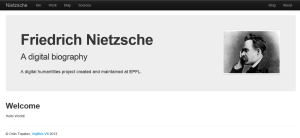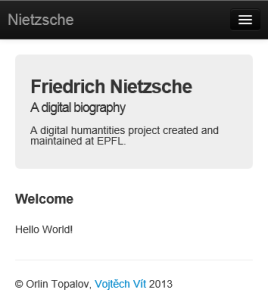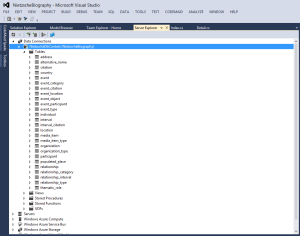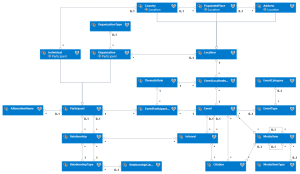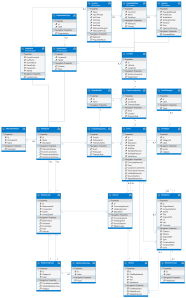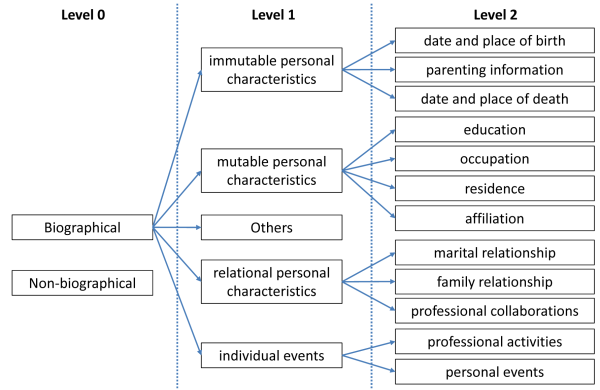Overview
Key Accomplishments of the Last Period
- The conceptual data model was finalized
- The intermediary structured database was finalized
- The project website basic UI was created
- The project MySQL database was created (only structure — no data)
- The project website ORM software was configured to use the project database — an object model was created and mapped to the database
Upcoming Tasks for the Next Period
- Complete the website development
- Summarize project results
- Prepare a poster
Issues
All significant events in Nietzsche’s life have been extracted and imported in the database. Interpersonal relationships are left to be inferred from the collected biographical information for the completion of the data analysis.
Major Task Completion
| Planned Complete Date | Actual Complete Date | Milestone |
|---|---|---|
| 20.02.2013 | 20.02.2013 | Project Start |
| 24.02.2013 | 01.03.2013 | Data Collection — Complete Source Aggregation |
| 10.03.2013 | 10.03.2013 | Data Collection — |
| 24.03.2013 | t.b.a. | Data Collection — Complete Data Extraction and Database Population |
| 07.04.2013 | t.b.a. | Complete Data Analysis |
| 14.04.2013 | 22.04.2013 | Complete Website Design |
| 15.04.2013 | 29.04.2013 | Website Development Start |
Details on Accomplishments
Finalized Conceptual Model
Several changes have been applied to the conceptual model:
- The Album entity and the inheritance hierarchy of Media Item have been deprecated. All media items will be stored in a single table. A media type property will be assigned to each item. Albums will be treated as compounded media items (defined by “part of” relationships).
- The Note, Citation and Source entities have been merged in a single Citation entity, which will hold excerpts from documents, as well as standalone quotes and references to multimedia objects. Citations are linked to Intervals and Events
- The Keyword entity has been dropped. Information about individuals and organizations will be stored in their corresponding tables.
- Interpersonal relationships have been linked to Intervals.
- An Importance attribute has been added to Events. It is a positive integer in the interval between 1 and 10, which will indicate the significance of individual events (10 – being the highest and 1 – the lowest). It will further allow us to filter events more precisely.
- Media Items can be linked to Events.
In addition, the Agent entity has been renamed to Participant, and it now participates in a single many-to-many relationship with Event. This help us define different thematic roles for all nouns, present in a sentence describing an event, and thus preserve more relevant and structured information (see Thematic Roles, from ref. 1). Typical thematic roles include: agent, patient, theme, recipient, beneficiary, location, origin, direction, instrument, experiencer.
The final conceptual data model (version 1.3) for the project is available for download at https://nietzschebiography.files.wordpress.com/2013/05/conceptual_model_v1-3.pdf
Finalized Intermediary Structured Database
The physical data model for the project is available for download at https://nietzschebiography.files.wordpress.com/2013/05/physical_model_v1-0.pdf
Basic Project Web Site UI
The project web site user interface was based on Bootstrap, an open-source template which simplifies meeting current market requirements on website UIs. Thanks to this decision, making the web site adaptable to various screen sizes and compliant with the newest WWW standards was made much easier.
Below you may see a few screenshots of the user interface design:
Project MySQL database
The project relational database model was continuously updated and has now reached a pre-release version that may be already used as a basis for further programming work. The model was therefore exported from the designer into SQL DDL and this script was launched on MySQL database that is part of our Windows Azure project web site.
On the screenshot below, you may see the tables stored in the project database.
Web Site ORM Configured
Since we chose Microsoft ASP.NET MVC as the backend technology and it is based on Microsoft .NET Framework, an object oriented programming platform, it was convenient for us to use ORM software as a data access layer in order to bring the relational and object oriented worlds together. For this purpose, we chose Entity Framework v5.0, a Microsoft’s official ORM technology, especially due to a very good tooling support.
To make the ORM work, however, it was necessary to create an object equivalent of the relational database model. The screenshots below show the resulting object model.
References
1. Santorini, Beatrice, and Anthony Kroch. 2007-.
The syntax of natural language: An online introduction using the Trees program.
http://www.ling.upenn.edu/~beatrice/syntax-textbook
